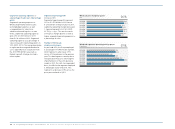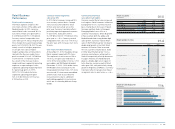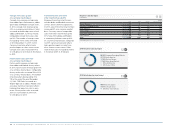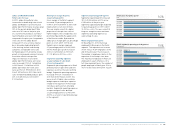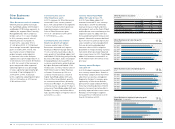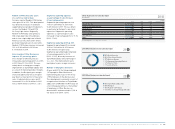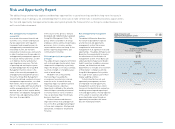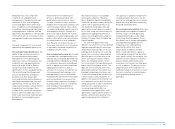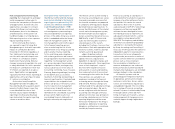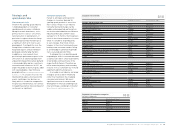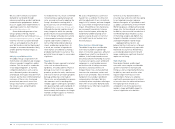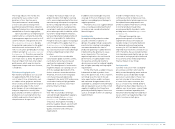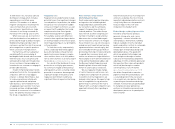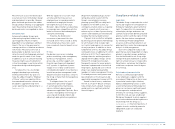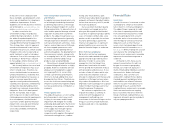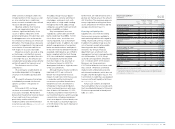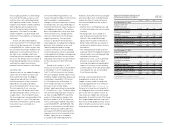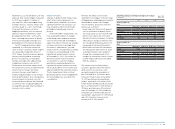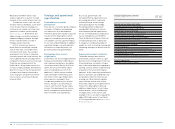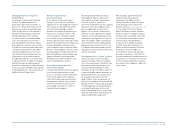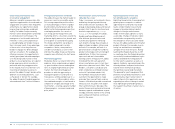Reebok 2010 Annual Report Download - page 166
Download and view the complete annual report
Please find page 166 of the 2010 Reebok annual report below. You can navigate through the pages in the report by either clicking on the pages listed below, or by using the keyword search tool below to find specific information within the annual report.
162 Group Management Report – Financial Review Risk and Opportunity Report
We also seek to enhance consumer
demand for our brands through
extensive marketing, product and brand
communication programmes. And we
focus on supply chain improvements to
speed up creation-to-shelf timelines
see Global Operations, p. 106.
Given the broad spectrum of our
Group’s product offering, retailer
feedback and other early indicators see
Internal Group Management System, p. 126, we
view the risk from consumer demand
shifts as unchanged versus the prior
year. We therefore rate the likelihood of
changes in consumer demand as likely,
and the potential financial impact as
moderate.
Industry consolidation risks
The adidas Group is exposed to risks
from market consolidation and strategic
alliances amongst competitors and/or
retailers. This can result in a reduction
of our bargaining power, or harmful
competitive behaviour such as price
wars. Abnormal product discounting
and reduced shelf space allocation from
retailers are the most common potential
outcomes of these risks. Sustained
promotional pressure in one of the
Group’s key markets could threaten
the Group’s sales and profitability
development.
To moderate this risk, we are committed
to maintaining a regionally balanced
sales mix and continually adapting the
Group’s distribution strategy with a
particular focus on controlled space
initiatives see Global Sales Strategy, p. 82.
Although the market capitalisation of
many companies within the sporting
goods industry increased substantially
in 2010, merger and acquisition activity
is forecasted to intensify in the light
of good credit market conditions as
well as improving corporate balance
sheets and business projections. As
a result, we continue to regard risks
from market consolidation as having a
probable likelihood of occurrence. The
potential financial impact is assessed as
significant.
Hazard risks
The adidas Group is exposed to external
risks such as natural disasters,
epidemics, fire and accidents. Physical
damage to our own or our suppliers’
premises, production units, warehouses
and stock in transit can lead to property
damage and business interruption.
These risks are mitigated by loss preven-
tion measures such as working with
reliable suppliers and logistics providers
who guarantee high safety standards. In
addition to the insurance coverage we
have secured, the Group has also imple-
mented contingency plans to minimise
potential negative effects.
We assess the potential occurrence of
hazard risks as unlikely. In connection
with the adjustment of our risk method-
ology in 2010, however, we have changed
our assessment of the potential financial
impact. Should those risks materialise,
we now expect hazard risks to have a
major financial impact, reflecting the
fundamental and devastating conse-
quences natural disasters or terrorist
acts might have on our business on a
theoretical basis.
Risks from loss of brand image
The adidas Group faces considerable
risk if we are unable to uphold high
levels of consumer awareness, affiliation
and purchase intent for our brands. In
addition, if the Group’s brands are not
allocating sufficient marketing resources
to activate our sports assets and brand
campaigns in a sustainable manner,
we face the risk of fading consumer
awareness and attractiveness. To
mitigate these risks, we have defined
clear mission statements, values and
goals for all our brands. These form the
foundation of our product and brand
communication strategies. We also
continually refine our product offering to
meet shifts in consumer demand and to
contemporise our offering to respond to
current trends.
Central to all our brand initiatives is
ensuring clear and consistent messaging
to our targeted consumer audience.
Market share gains at TaylorMade as well
as adidas’ achievements at the 2010 FIFA
World Cup give us confidence that brand
image risks for these brands are unlikely.
In addition, the successful introduction of
new Reebok product initiatives such as
in the toning category and ZigTech has
helped to stimulate consumer interest
and improve Reebok’s brand image.
Aggregating these factors, we
believe that the risk from loss of brand
image for the Group has only a possible
likelihood of occurrence. Nevertheless,
a considerable deterioration in brand
image could have a significant financial
impact on our Group.
Own-retail risks
New adidas, Reebok and Rockport
own-retail stores require considerable
up-front investment in furniture and
fittings as well as ongoing maintenance.
In addition, own-retail activities often
require longer-term lease or rent
commitments. Retail also employs
significantly more personnel in relation
to net sales than our wholesale business.
The higher portion of fixed costs
compared to our wholesale business
implies a larger profitability impact in
cases of significant sales declines.


